How to Hang a Plant From the Ceiling Without Holes

If you’ve run out of room for your houseplants, you’re probably looking up for extra space. Hanging plants from the ceiling may conjure up vintage macrame nets, but houseplant parents have become quite creative since the 1970s when it comes to corded planters!
We’ll show you how to hang a plant from the ceiling without holes so if you live in a rental or don’t want to mar your newly-painted ceilings, you can enjoy the more modern look of hanging houseplants both indoors and outdoors.
Remember, after you remove your hanging plants, those eyesore holes are still visible. Luckily, there are alternatives—keep reading to find them out.
Disclaimer: Hometalk may receive a small affiliate commission from purchases made via Amazon links in this article but at no cost to you.
How to Hang Plants from the Ceiling Without Drilling Holes
There are plenty of ways to hang plants without drilling, but there are two caveats to consider. First, you have to make sure that you place plants in a spot where there’s at least a bit of natural light if not plenty of streaming sunshine. Don’t hang houseplants in a dark room unless you know for sure you have a plant that prefers low light to thrive.
Second, consider the weight of the plant plus water. According to Dave’s Garden, a hanging plant—planter, plant, and soil— weighs a minimum of seven pounds, but larger plants can weigh up to 25 pounds, and that doesn’t account for water.
We'll detail this more in the following ways to hang plants from the ceiling without drilling holes; some methods are better suited for heavier plants, while others might be more fit for light plants like herbs.
S-Hooks Are Your Best Friend
Adhesive Hooks
Heavy-duty removable adhesive hooks can be applied to a smooth ceiling surface. Just make sure you know the maximum weight the hook will hold. For example, you can get a hook that holds 22 pounds max, but make sure you know how much your hanging plant will actually weigh once it’s watered.
Magnetic Hooks
Do you have an exposed air duct, pipe, or other metal fixture on your ceiling in just the right spot for a hanging plant? You are in extreme luck thanks to heavy-duty magnetic hooks. Opt for a hook that can safely hold 100 pounds of weight.
Suction Cups
If your ceiling has skylights, there are plenty of shades that attach to skylights using suction cups. So why not hang plants from a heavy-duty suction cup that clamps onto the glass of skylights? Look for strong cups that are used for holding down camping gear on car windows, which have a loop attached to hang the planter from.
Keeping Plants Out of Reach
Tension Rods
Hang plants without drilling with the magic of tension rods. Adjustable tension rods can run as wide as 54 inches, so you can easily place one from wall to wall, cabinet to cabinet, or within a window frame and hang your plants from it (this is where S hooks come in handy). If you want a chunkier look, try a shower curtain tension rod.
There are also vertical tension rods designed to hold plants on hooks (it’s along the same lines as a floor-to-ceiling cat tree tension rod). Many vertical tension rods come with built-in hooks or holes to hang hooks from. Or, if plants aren't too big and heavy, you can zip-tie pots to the rod.
Drapery Rods
You can use your existing drapery rods in two ways. Either hang plants directly from the rods as you would from a tension rod. Or, hang plants from sturdy finials on either side of the rod for a balanced and decorative look.
Lattice
Lattice is always pretty, inside or out. Paint it the color of your ceiling, stain it, spray paint it, or leave it bare. Home improvement stores, such as Home Depot, have plenty of framed pieces—including unusual decorative lattice pieces—that you can attach to the ceiling (or wall).
Attach a lattice to your ceiling and use S-hooks to hang lightweight plants. You can do the same with a pot rack or even a hanging plant ladder. Hanging a lattice does require drilling into the ceiling, however, a lattice will allow you to hang multiple plants without drilling too many holes in random spots on your ceiling.
Heavy-Duty Spring Clamps
General-purpose clamps are handy if you have a spot such as a doorway, wood window valance, or a vertical hanging piece of wall over a window where you’d like to place a hanging plant without drilling a hole.
They may not be the prettiest solution, but they do the job—eyes will be drawn to your plant, after all. Make sure you read how much weight one clamp will hold, and remember, if you are clamping a plant, make it a lightweight one.
Drop Ceiling Hooks
If you’ve got a drop ceiling, you’re in luck. There are special hooks to slip over the grid that let you hang lighter-weight houseplants.
Alternatives to Hanging Plants from the Ceiling
If you just want to ditch the hanging-from-the-ceiling thing altogether, there are still plenty of ways to display your plants up high:
- Hanging plant shelf: Use your existing curtain rod to hang a plant shelf. It will look like the plants are hanging from the ceiling, but not one hole was drilled! Or try a suction cup planter shelf or a suction cup planter box for your windows...beats drilling holes into the ceiling!
- Wall sconces: Do you have a couple of wall sconces that aren’t used? Take out the bulb, cut the electricity to the sconce, line it with plastic, and put the planter in. You can also use an S-hook to hang the plant from the edge of the sconce.
- Window pockets/grow bags: Indoors or out, grow pockets make your walls come alive. Some even have pockets large enough for you to fit in the pot itself.
- Pegboard: Use a pegboard to hang plants from hooks or add shelves that plants can perch on.
- Coat rack: A mobile vertical coat rack is ideal for hanging medium-weight plants as long as you have equal weight throughout.
- Coat rail rack of hooks: A coat rail (even a decorative metal finished towel rack) is perfect to hold plants up high. Use it in your entryway as a welcoming little wall garden.
- Clothing rack: A simple clothing rack with a horizontal pole placed in front of a window works well for heavier plants. They are the perfect height for watering, too.
- Over-the-door rack: If you have a door that’s bare and in need of some green, why not hang a few pots of plants from an over-the-door rack? Make sure the door is one that’s hardly used and is near a source of natural light for your plants.
- Convert a playset: If you don’t have an arbor or overhead structure to hang plants from outdoors, here’s a creative upcycling idea: convert a playset into a hanging plant center. Strip the playset down to the frame and add hooks on the underside of the top bar.
How to Care for Hanging Plants
Whether your hanging plants are inside or out, they tend to need more watering because containers dry out faster than plants grown in the ground. Also, plants in the air are subject to drying breezes, according to Horticulture Magazine.
But watering is not always easy when you’re reaching above your head to water plants! You can always create a custom watering system with a tube that delivers water to each plant. Or, you can make your life easier by using a watering can or sprayer specifically designed for plants hanging outside. Add a stepping stool to your watering routine to make it even faster and easier to get the job done.
Watering hanging plants indoors can make quite a watery mess—especially if you have a planter with a drainage hole, but no catch pan for drips. The best thing to do is to remove the plant from its hanger and take it to the sink to water. Wait until water is done dripping out the drain hole before hanging it back up, say the experts from Planterina in Bridgehampton, New York.
Share the creative and secret ways you have managed to hang plants from the ceiling without drilling holes!



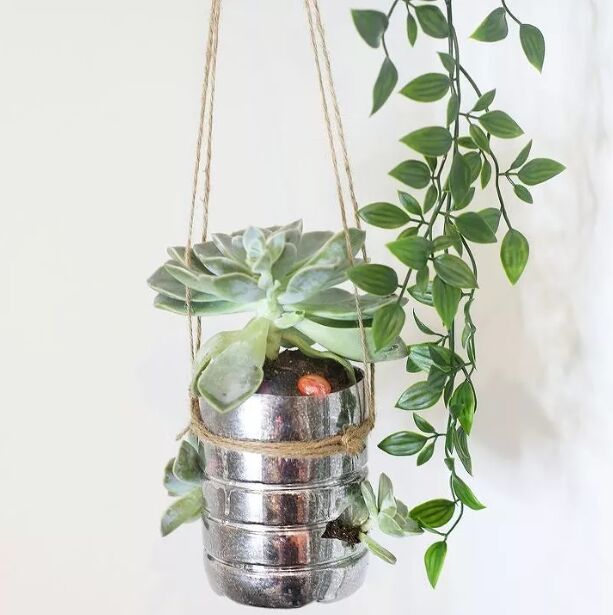






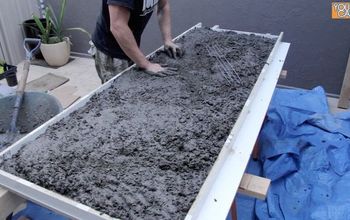



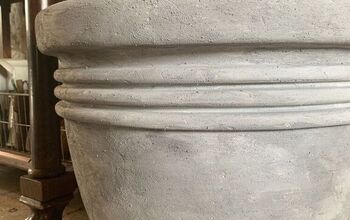



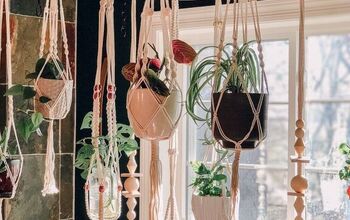
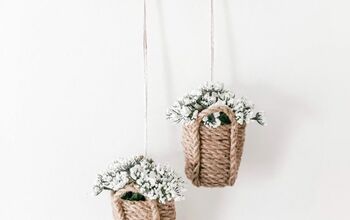
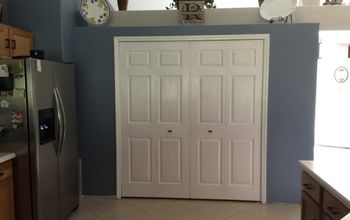
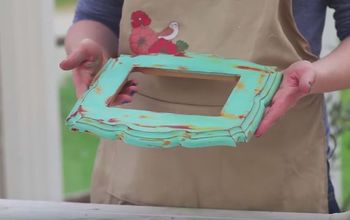

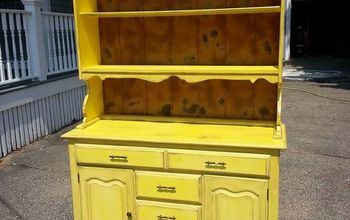
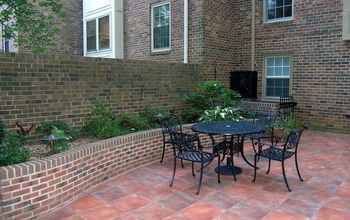



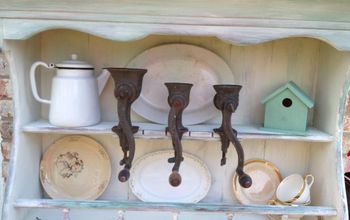

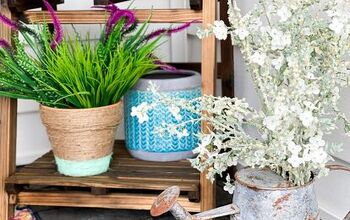

Frequently asked questions
Have a question about this project?
Hi. Is there a way, other then trial and error, to determine how much weight a tension rod can hold? I’m assuming you’re using the kind you use for a shower curtain. Thanks!